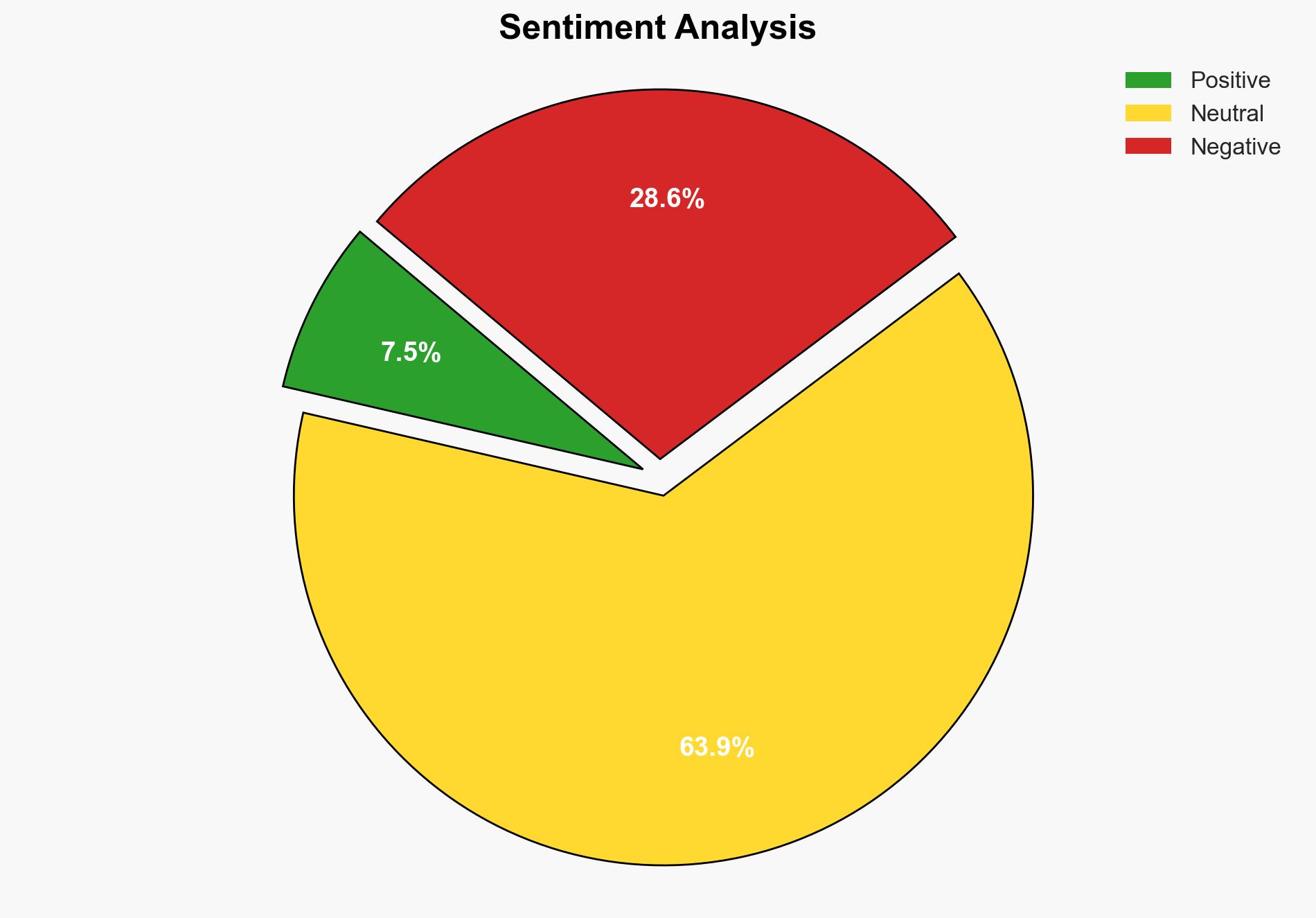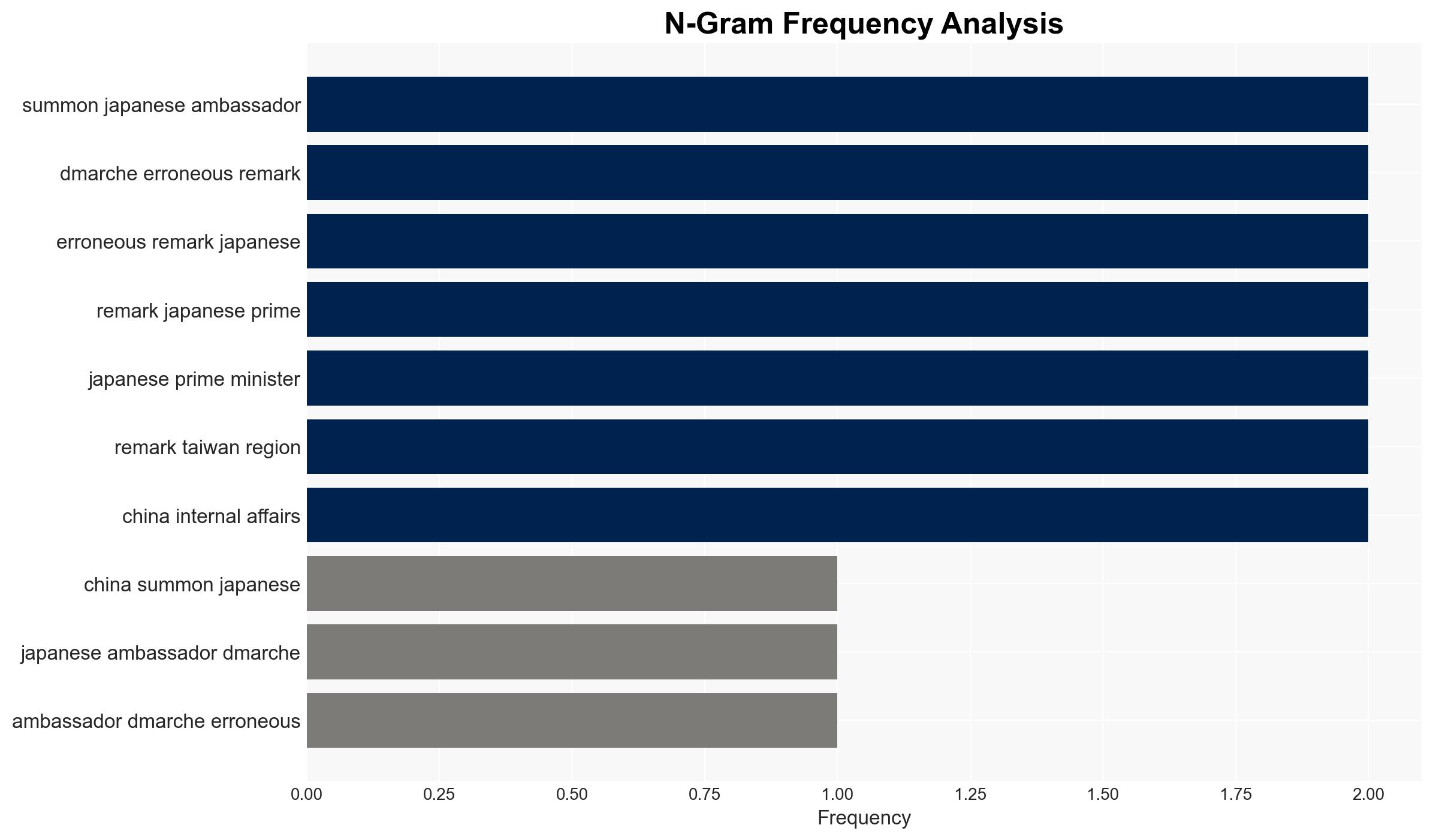China summons Japanese ambassador makes serious dmarches over erroneous remarks of Japanese Prime Minister regarding China – Globalsecurity.org
Published on: 2025-11-14
AI-powered OSINT brief from verified open sources. Automated NLP signal extraction with human verification. See our Methodology and Why WorldWideWatchers.
Intelligence Report: China summons Japanese ambassador makes serious dmarches over erroneous remarks of Japanese Prime Minister regarding China – Globalsecurity.org
1. BLUF (Bottom Line Up Front)
China’s summoning of the Japanese ambassador and subsequent démarche reflects heightened tensions over Taiwan-related remarks by a Japanese official. This incident underscores the sensitivity of Taiwan in Sino-Japanese relations and the potential for diplomatic escalation. The most supported hypothesis is that China aims to deter Japan from further commentary on Taiwan, leveraging historical grievances and international norms. Confidence Level: Moderate. Recommended action includes diplomatic engagement to clarify positions and reduce tensions.
2. Competing Hypotheses
Hypothesis 1: China’s démarche is a calculated diplomatic maneuver to reinforce its red lines on Taiwan and deter Japan from supporting Taiwan’s independence or intervention in the Taiwan Strait.
Hypothesis 2: The démarche is primarily a domestic signaling tool, aimed at consolidating internal support by showcasing a strong stance against perceived foreign interference in China’s core interests.
Assessment: Hypothesis 1 is more likely given China’s historical emphasis on Taiwan as a core interest and its strategic use of diplomatic pressure to influence international discourse. Hypothesis 2, while plausible, is less supported by the evidence as the primary motive, though it may serve as a secondary benefit.
3. Key Assumptions and Red Flags
Assumptions: It is assumed that China’s démarche reflects genuine concern over Japan’s stance on Taiwan rather than being purely performative. It is also assumed that Japan’s remarks were not intended to provoke but rather reflect a broader regional security perspective.
Red Flags: The potential for misinterpretation of diplomatic signals could escalate tensions. China’s emphasis on historical grievances may be used to justify broader strategic objectives.
Deception Indicators: There is a risk that China’s public statements may not fully align with its private diplomatic communications, potentially obscuring true intentions.
4. Implications and Strategic Risks
The incident highlights the risk of diplomatic escalation between China and Japan, with potential impacts on regional stability. Politically, it could strain bilateral relations and complicate multilateral engagements involving Taiwan. Economically, prolonged tensions may affect trade relations. Informationally, both nations may engage in narrative shaping to bolster domestic and international support. Cyber risks include potential retaliatory actions targeting critical infrastructure or information systems.
5. Recommendations and Outlook
- Engage in diplomatic dialogue to clarify intentions and reduce misinterpretations.
- Encourage multilateral forums to address regional security concerns involving Taiwan.
- Monitor for escalation indicators, particularly in military posturing or economic sanctions.
- Best-case scenario: Diplomatic engagement leads to de-escalation and reaffirmation of peaceful dialogue.
- Worst-case scenario: Escalation leads to increased military tensions and economic sanctions.
- Most-likely scenario: Continued diplomatic friction with periodic escalations, but no immediate military conflict.
6. Key Individuals and Entities
Sun Weidong (Chinese Vice Foreign Minister), Kenji Kanasugi (Japanese Ambassador to China), Sanae Takaichi (Japanese Prime Minister).
7. Thematic Tags
Structured Analytic Techniques Applied
- Cognitive Bias Stress Test: Expose and correct potential biases in assessments through red-teaming and structured challenge.
- Bayesian Scenario Modeling: Use probabilistic forecasting for conflict trajectories or escalation likelihood.
- Network Influence Mapping: Map relationships between state and non-state actors for impact estimation.
Explore more:
National Security Threats Briefs ·
Daily Summary ·
Support us
·





